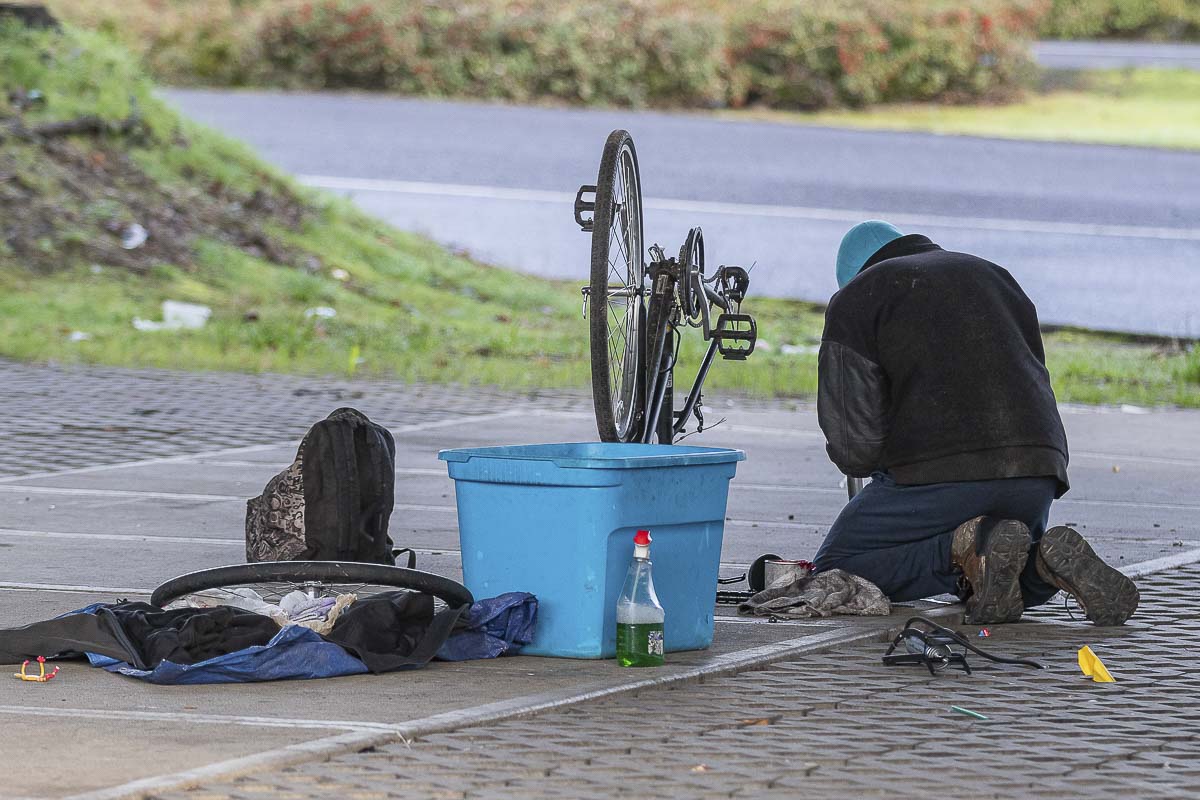Nonprofits met this week to break down the 2020 point in time count and look at what’s ahead
CLARK COUNTY — The 2020 Homeless Point in Time Count for Clark County was released last week, showing a slight decline in the overall homeless population, but a rise in the number of people living unsheltered in the area.

Details from the count are available at our previous story here.
Clark County homeless population increasingly unsheltered

On Wednesday, the Clark County Council for the Homeless hosted a one-hour online webinar, with members of several area homeless nonprofits, to go over the data and answer community questions.
The Jan. 30 count, which involved 60 people spread out over 16 teams, found 916 people experiencing homelessness. Of those, 516 were unsheltered.
That number was up from 487 in 2019, and well over double the number of unsheltered homeless found in 2015, when 206 people were surveyed on the street in Clark County.
There are a number of factors that could account for the increase, noted Jillian Daleiden, community wellness program director for Share.
“Share runs two family shelters, Orchards Inn and Homestead, and towards the end of summer 2019, or early fall, we closed Orchards Inn for renovations,” Daleiden said. “And that’s about 50 individuals who were not not able to be accessing that shelter due to the renovations.”
The plan, Daleiden added later, was to renovate the shelter before the winter months, but Vancouver Housing Authority had a contractor pull out of the project, along with running into other issues, which delayed completion.
Orchards Inn is expected to reopen in the near future, though Homestead will close shortly afterwards for renovations there.
Still, Daleiden says they’re seeing a decrease in the numbers of people living in the downtown area, or along the waterfront. Those populations seem to be increasingly moving into wooded areas along SR-500, or even out towards Battle Ground and Ridgefield.
The reopening of Orchards Inn, along with a 20-tent, city-sanctioned encampment outside of Living Hope Church on Andresen, means the city will see a significant increase in emergency shelter beds. Amid the COVID-19 pandemic, St. Andrews and St. Paul Lutheran churches, along with the Share House downtown, have been able to maintain funding for their winter weather shelter beds.
Clark County also funded the use of a hotel where homeless individuals who test positive for COVID-19 can be quarantined.
The data from this year also revealed a 24 percent increase in the number of unsheltered youth, ages 18-24, living on the streets.
“On the surface that can seem very alarming,” said Laura Ellsworth, the strategic partnerships manager for Council for the Homeless, “but in reality, the majority of this increase can be attributed to the Vancouver Housing Authority’s opening of Caples Terrace.”
The 28-unit affordable housing development in Vancouver’s Skyline neighborhood, which opened last July, is a transitional facility for young people who have aged out of the foster care system, but lack the means to afford standard housing.
“Traditionally they are just really hard to find and count.” said Ellsworth. “They’re still actually considered homeless even though they’re in transitional housing. So we just were able to count them more.”


The number of people experiencing homelessness who are over the age of 62 also continues a steady rise, with 62 people falling into that category this year, a 7 percent increase from last year’s count.
“Nearly 100 percent of the seniors identified a lack of income as the reason for their homelessness,” noted Ellsworth. “We know that Social Security and pensions are not keeping up with increasing rents and utilities and food costs, especially if you’re living alone.”
The Safe Park program, which is spread across 10 different churches, has at least 40 families living in their vehicles, according to David Bilby, head of GoConnect which runs the program.
“About a third are people over 50,” said Bilby, “and that’s slowly increasing.”
Bilby said area churches have really “picked up the baton” for serving older individuals.
“We had a family, the husband and wife have been married for 42 years, living in their van right now,” said Bilby. “They thought their pension was covered. At the end of the day, whether it was fraud or whatever happened, I’m not really sure, they don’t have that income they thought they were going to have.”
Around 60 percent of the people using the Safe Park program are employed full-time, Bilby says, and many are younger families struggling to find a way into permanent housing.
Dale Whitley, who runs the Homeless Management Information System (HMIS) and coordinates the Point in Time Count, noted that this was the second year that teams have had access to a mobile app, which assists in asking questions and making sure people aren’t being counted twice.
They also worked with the Clark County Sheriff’s Office and Vancouver Police to try and avoid raids of homeless encampments in the time leading up to the count.
“We’ve had trouble with that before,” said Whitley. “And it’s frustrating when it confounds our ability to produce the best numbers that we can.”
In terms of homelessness response, Clark County is the main governing body responsible for funding outreach programs and shelter beds. The city of Vancouver, however, has also invested heavily in housing and rental assistance through their Affordable Housing Fund property tax levy.
The two governments have talked increasingly in recent months about forming a joint committee on the issue of homelessness. Vancouver City Councilors decided to press pause on a plan to reopen the Navigation Center at Fourth Plain and Grand until the county could be brought in to work on the details.
At its most recent council meeting, Clark County officially accepted nearly $27 million in funding from the CARES Act, approved by congress. The money is available on a refund basis to help cover expenses related to COVID-19 after the fact.
Kate Budd, executive director with the Council for the Homeless, said some of that funding could be used for rental assistance to people at risk of losing their housing.
“That’s very much an advocacy opportunity within all jurisdictions here in Clark County,” said Budd, “is to ask your elected officials, please consider providing rent assistance.”
Ellsworth added that the current racial unrest following the in-custody death of George Floyd in Minneapolis, Minnesota could also provide an opportunity to highlight the disproportionate impact homelessness has on minority communities across the country, including Clark County.
Races other than white make up 14 percent of the county’s population, but account for 24 percent of those experiencing homelessness. That includes 9 percent Hispanic or Latino, and 7 percent Black.
“We’re not going to end homelessness without ending systemic racism,” Ellsworth said at the end of the webinar. “You can see how disproportionately impacted people of color are by homelessness, poverty, health care disparities, all of it.”




